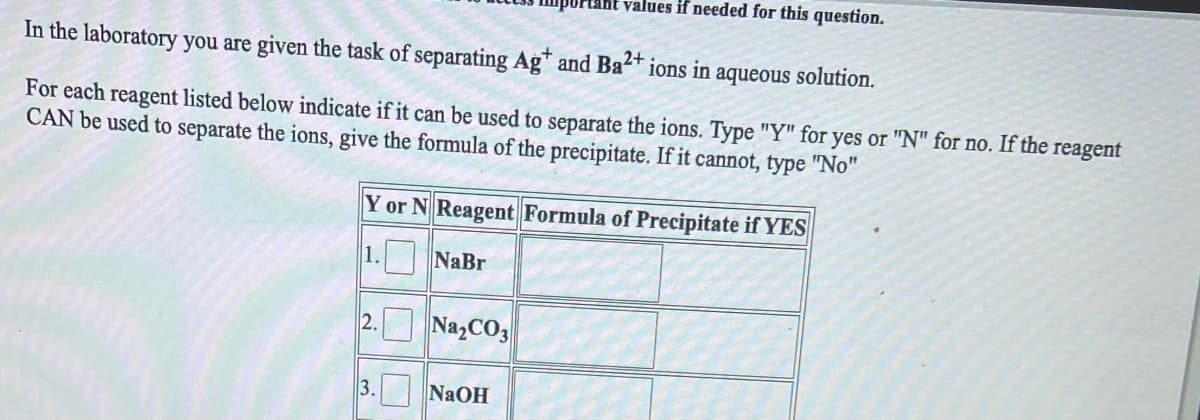Consider the insoluble compound silver hydroxide , AgOH. The silver ion also forms a complex with ammonia. Write a balanced net ionic equation to show why the solubility of AgOH (s) increases in the presence of ammonia and calculate the equilibrium constant for this reaction. For Ag(NH3),*, Kç= 1.6×107 . Be sure to specify states such as (aq) or (s). + K =
Consider the insoluble compound silver hydroxide , AgOH. The silver ion also forms a complex with ammonia. Write a balanced net ionic equation to show why the solubility of AgOH (s) increases in the presence of ammonia and calculate the equilibrium constant for this reaction. For Ag(NH3),*, Kç= 1.6×107 . Be sure to specify states such as (aq) or (s). + K =
Chemistry: Principles and Reactions
8th Edition
ISBN:9781305079373
Author:William L. Masterton, Cecile N. Hurley
Publisher:William L. Masterton, Cecile N. Hurley
Chapter15: Complex Ion And Precipitation Equilibria
Section: Chapter Questions
Problem 61QAP
Related questions
Question

Transcribed Image Text:Consider the insoluble compound silver hydroxide , AgOH. The silver ion also forms a complex with ammonia. Write a
balanced net ionic equation to show why the solubility of AgOH (s) increases in the presence of ammonia and calculate the
equilibrium constant for this reaction.
For Ag(NH3),*, Kç= 1.6×107 . Be sure to specify states such as (aq) or (s).
+
K =

Transcribed Image Text:values if needed for this question.
In the laboratory you are given the task of separating Ag* and Ba* ions in aqueous solution.
2+.
For each reagent listed below indicate if it can be used to separate the ions. Type "Y" for yes or "N" for no. If the reagent
CAN be used to separate the ions, give the formula of the precipitate. If it cannot, type "No"
Y or N Reagent Formula of Precipitate if YES
1. NaBr
2. Na,CO3
3. NaOH
Expert Solution
This question has been solved!
Explore an expertly crafted, step-by-step solution for a thorough understanding of key concepts.
Step by step
Solved in 2 steps with 1 images

Knowledge Booster
Learn more about
Need a deep-dive on the concept behind this application? Look no further. Learn more about this topic, chemistry and related others by exploring similar questions and additional content below.Recommended textbooks for you

Chemistry: Principles and Reactions
Chemistry
ISBN:
9781305079373
Author:
William L. Masterton, Cecile N. Hurley
Publisher:
Cengage Learning

Chemistry: Principles and Practice
Chemistry
ISBN:
9780534420123
Author:
Daniel L. Reger, Scott R. Goode, David W. Ball, Edward Mercer
Publisher:
Cengage Learning

Principles of Modern Chemistry
Chemistry
ISBN:
9781305079113
Author:
David W. Oxtoby, H. Pat Gillis, Laurie J. Butler
Publisher:
Cengage Learning

Chemistry: Principles and Reactions
Chemistry
ISBN:
9781305079373
Author:
William L. Masterton, Cecile N. Hurley
Publisher:
Cengage Learning

Chemistry: Principles and Practice
Chemistry
ISBN:
9780534420123
Author:
Daniel L. Reger, Scott R. Goode, David W. Ball, Edward Mercer
Publisher:
Cengage Learning

Principles of Modern Chemistry
Chemistry
ISBN:
9781305079113
Author:
David W. Oxtoby, H. Pat Gillis, Laurie J. Butler
Publisher:
Cengage Learning

Chemistry & Chemical Reactivity
Chemistry
ISBN:
9781337399074
Author:
John C. Kotz, Paul M. Treichel, John Townsend, David Treichel
Publisher:
Cengage Learning

General Chemistry - Standalone book (MindTap Cour…
Chemistry
ISBN:
9781305580343
Author:
Steven D. Gammon, Ebbing, Darrell Ebbing, Steven D., Darrell; Gammon, Darrell Ebbing; Steven D. Gammon, Darrell D.; Gammon, Ebbing; Steven D. Gammon; Darrell
Publisher:
Cengage Learning

Chemistry: An Atoms First Approach
Chemistry
ISBN:
9781305079243
Author:
Steven S. Zumdahl, Susan A. Zumdahl
Publisher:
Cengage Learning